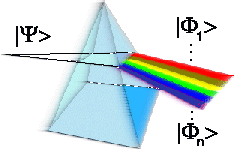Iwo Bialynicki-Birula and Zofia Bialynicka-Birula
A new method of introducing vortex lines of the electromagnetic field is outlined. The vortex lines arise when a complex Riemann–Silberstein vector is multiplied by a complex scalar function . Such a multiplication may lead to new solutions of the Maxwell equations only when the electromagnetic field is null, i.e. when both relativistic invariants vanish. In general, zeros of the function give rise to electromagnetic vortices. The description of these vortices benefits from the ideas of Penrose, Robinson and Trautman developed in general relativity.
Phys. Rev. A vol. 67, 062114-1-8 (2003)
Aug 29, 2003
Aug 18, 2003
Chemical diffusion in an interacting lattice gas: Analytic theory and simple applications
Zbigniew W. Gortel and Magdalena A. Załuska-Kotur
A variational approach to microscopic kinetics of an interacting lattice gas is presented. It accounts for the equilibrium correlations in the system and allows one to derive an algebraic expression for the particle density (coverage) dependent chemical diffusion coefficient for a wide variety of interaction models. Detailed derivation is presented for a one dimensional case for which the results are compared with the results of Monte Carlo simulations. Generalization and an application to the simplest case of the two dimensional lattice gas is briefly described.
Phys. Rev. B 70, 125431 (2004)
A variational approach to microscopic kinetics of an interacting lattice gas is presented. It accounts for the equilibrium correlations in the system and allows one to derive an algebraic expression for the particle density (coverage) dependent chemical diffusion coefficient for a wide variety of interaction models. Detailed derivation is presented for a one dimensional case for which the results are compared with the results of Monte Carlo simulations. Generalization and an application to the simplest case of the two dimensional lattice gas is briefly described.
Phys. Rev. B 70, 125431 (2004)
Subscribe to:
Comments (Atom)
